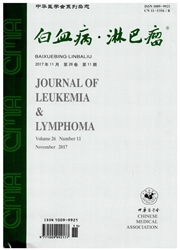

 中文摘要:
中文摘要:
目的 利用红色荧光蛋白(DsRed)标记的小鼠淋巴瘤EL4细胞株,建立荧光标记的小鼠白血病模型,并对模型进行分析和鉴定.方法 将EL4/DsRed细胞以低剂量(5×10^2/只)、中剂量(5×10^3/只)、高剂量(2.5×10^4/只)经尾静脉注入经清髓照射的C57BL/6小鼠体内,同时接种骨髓细胞5×10^6/只,采用流式细胞术(FCM)、反转录聚合酶链反应(RT-PCR)、组织病理等方法鉴定小鼠成模情况.结果 C57BL/6小鼠接种不同剂量EL4/DsRed细胞后白血病发病率达100%,移植后第2周FCM示受鼠肝、脾、骨髓和外周血中有大量EL4/DsRed细胞;各组组织器官病理检查呈现出不同程度的肿瘤细胞浸润.结论 用DsRed标记的EL4细胞以5×10^2/只植入C57BL/6小鼠,即可成功建立荧光标记的小鼠白血病模型,可为白血病发病机制、微小残留病检测等研究提供有价值的动物模型.
 英文摘要:
英文摘要:
Objective This study aimed to establish the leukemia mouse model by using EL4/DsRed cell line expressing red fluorescent protein (DsRed) and to evaluate the model. Methods After total body irradiation with X-ray of 7.0 Gy, C57BL/6 mice were inoculated 5×106 bone marrow cells mixed different numbers of EL4/DsRed cells via tail vein. The model was evaluated by flow cytometry (FCM), reverse transcriptase-polymerase chain reaction (RT-PCR), and histopathology. Results The incidence of leukemia was 100 %. The presence of EL4/DsRed cells was found in liver, spleen, bone marrow and peripheral blood of recipients by FCM two weeks after transplantation. Pathological section revealed that all recipients had several organs infiltration apparently. With the increase in the number of inoculated tumor cells, the survival time of recipients was reduced and the infiltration of leukemia cells in organs was more serious. Conclusion Mouse leukemia model was successfully established when C57BL/6 mouse was intravenously transplanted with ≥5×10^2 EIA/DsRed cells. The model could be employed usefully in the future research such as the pathogenesis of leukemia and minimal residual disease (MRD).
 同期刊论文项目
同期刊论文项目
 同项目期刊论文
同项目期刊论文
 Engineered regulatory T cells prevent graft-versus-host disease while sparing the graft-versus-leuke
Engineered regulatory T cells prevent graft-versus-host disease while sparing the graft-versus-leuke 期刊信息
期刊信息
